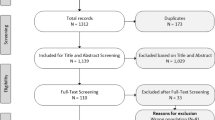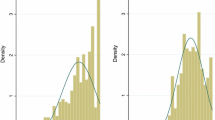Abstract
Background and Objectives
The aim of this study was to test the feasibility of estimating preference weights for all health states defined by the Child Health Utility 9D (CHU9D), a new generic measure of health-related quality of life for children aged 7–11 years. The estimation of preference weights will allow the calculation of QALYs for use in paediatric economic evaluation.
Methods
Valuation interviews were undertaken with 300 members of the UK adult general population to obtain preference weights for a sample of the health states in the CHU9D descriptive system. Both standard gamble and ranking valuation methods were used. Regression modelling was undertaken to estimate models that could predict a value for every health state defined by the system. A range of models were tested and were evaluated based on their predictive performance.
Results
Models estimated on the standard gamble data performed better than the rank model. All models had a few inconsistencies or insignificant levels and so further modelling was done to estimate a parsimonious consistent regression model using the general-to-specific approach, by combining inconsistent levels and removing non-significant levels. The final preferred model was an ordinary least squares (OLS) model. All the coefficients in this model were significant, there were no inconsistencies and the model had the best predictive performance and a low mean absolute error.
Conclusion
This research has demonstrated it is feasible to value the CHU9D descriptive system, and preference weights for each health state can be generated to allow the calculation of QALYs. The CHU9D can now be used in the economic evaluation of paediatric healthcare interventions. Further research is needed to investigate the impact of children’s preferences for the health states and what methods could be used to obtain these preferences.











Similar content being viewed by others
References
Brazier JE, Ratcliffe J, Salomon J, et al. Measuring and valuing health benefits for economic evaluation. Oxford: Oxford University Press, 2007
Ungar WJ, Gerber A. The uniqueness of child health and challenges to measuring costs and consequences. In: Ungar WJ, editor. Economic evaluation in child health. Oxford: Oxford University Press, 2010: 3–33
Torrance G, Feeny D, Furling W, et al. Multiattribute utility function for a comprehensive health status classification system: Health Utilities Index mark 2. Med Care 1996; 34: 702–22
Ravens-Sieberer U, Wille N, Badia X, et al. Feasibility, reliability, and validity of the EQ-5D-Y: results from a multinational study. Qual Life Res 2010; 19(6): 887–97
Moodie M, Richardson J, Rankin B, et al. Predicting time trade-off health state valuations of adolescents in four pacific countries using the AQoL-6D instrument. Value Health 2010; 13: 1014–27
Stevens KJ. Developing a descriptive system for a new preference-based measure of health related quality of life for children. Qual Life Res 2009; 18(8): 1105–13
Stevens KJ. Working with children to develop dimensions for a preference-based, generic, pediatric health-related quality-of-life measure. Qual Health Res 2010; 20(3): 340–51
Stevens K. Assessing the performance of a new generic measure of health-related quality of life for children and refining it for use in health state valuation. Appl Health Econ Health Policy 2011; 9(3): 157–69
Gold MR, Siegel JE, Russell LB, et al. Cost effectiveness in health and medicine. Oxford: Oxford University Press, 1996
Brazier JE, Deverill M, Harper R, et al. A review of the use of health status measures in economic evaluation. Health Technol Assess 1999; 3(9): i–iv, 1–164
National Institute for Health and Clinical Excellence. Guide to the methods of technology appraisal. London: NICE, 2004 Apr
Brazier JE, Roberts J, Deverill M. The estimation of a preference based measure of health from the SF-36. J Health Econ 2002; 21(2): 271–92
McCabe C, Stevens K, Roberts J, et al. Health state values for the HUI2 descriptive system: results from a UK survey. Health Econ 2005; 14(3): 231–44
Stevens KJ, Brazier JE, McKenna SP, et al. The development of a preference-based measure of health in children with atopic dermatitis. Br J Derm 2005; 153: 372–7
MVH Group, Dolan P, Gudex C, et al. The measurement and valuation of health: first report on the main survey. York: Centre for Health Economics, University of York, 2004
AFD Names and Numbers® [computer program]. Ramsey: AFD Software [online]. Available from URL: http://www.afd.co.uk/manuals/namesandnumbers/contents.htm [Accessed 2008 Mar 7]
Dolan P. Modelling valuations for EuroQol health states. Med Care 1997; 35(11): 1095–108
Patrick DL, Starks HE, Cain KC, et al. Measuring preferences for health states worse than death. Med Decis Making 1994; 14: 9–18
McCabe C, Brazier JE, Gilks P, et al. Using rank data to estimate health state utility models. J Health Econ 2006; 25: 418–31
O’Brien BJ, Drummond MF. Statistical versus quantitative significance in the socioeconomic evaluation of medicines. Pharmacoeconomics 1994; 5(5): 389–98
Ljung G, Box G. On a measure of lack of fit in time series models. Biometrika 1979; 66: 265–70
Brazier JE, Roberts JR. The estimation of a preference-based measure of health from the SF-12. Med Care 2004; 42(9): 851–9
Walters SJ, Brazier JE. Comparison of the minimally important difference for two health state utility measures: EQ-5D and SF-6D. Qual Life Res 2005; 14: 1523–32
Lloyd A. Threats to the estimation of benefit: are preference estimation methods accurate? Health Econ 2003; 12: 393–402
Ratcliffe J, Couzner L, Flynn T, et al. Valuing Child Health Utility 9D health states with a young adolescent sample: a feasibility study to compare best-worst scaling discrete-choice experiment, standard gamble and time trade-off methods. Appl Health Econ Health Policy 2011; 9(1): 15–27
Ratcliffe J, Flynn T, Terlich F, et al. A pilot study to apply best worst scaling discrete choice experiment methods to obtain adolescent specific values for the Child Health Utility 9D [Flinders Centre for Clinical Change and Health Care Research working paper no. 2011/1]. Adelaide: Flinders University, 2011
Petrou S. Methodological issues raised by preference-based approaches to measuring the health status of children. Health Econ 2003; 12(8): 697–702
Ungar WJ. Challenges in health state valuation in paediatric economic evaluation: are QALYs contraindicated? Pharmacoeconomics 2011; 29(8): 641–52
Ratcliffe J, Brazier JE, Tsuchiya A, et al. Using DCE and ranking data to estimate cardinal values for health states for deriving a preference-based single index from the sexual quality of life questionnaire. Health Econ 2009; 18(11): 1261–76
Brazier J, Rowen D, Yang Y, et al. Comparison of health state utility values derived using TTO, rank and DCE data anchored on the full health-dead scale. Eur J Health Econ 2010; 11:215–25
Sung L, Young NL, Greenberg ML, et al. Health-related quality of life (HRQL) scores reported from parents and their children with chronic illness differed depending on utility elicitation method. J Clin Epidemiol 2004 Nov; 57(11): 1161–6
Acknowledgements
This research was funded as part of a UK Medical Research Council Special Training Fellowship in Health Services and Health of the Public Research. The work carried out is independent of the funders. Thanks from the author go to the CRE at Sheffield Hallam University and to all the participants who took part.
This paper is part of a theme issue co-edited by Lisa Prosser, University of Michigan, USA, and no external funding was used to support the publication of this theme issue.
Author information
Authors and Affiliations
Corresponding author
Rights and permissions
About this article
Cite this article
Stevens, K. Valuation of the Child Health Utility 9D Index. PharmacoEconomics 30, 729–747 (2012). https://doi.org/10.2165/11599120-000000000-00000
Published:
Issue Date:
DOI: https://doi.org/10.2165/11599120-000000000-00000




